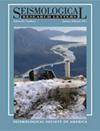沿墨西哥俯冲带重复的大地震
IF 3.2
3区 地球科学
Q2 GEOCHEMISTRY & GEOPHYSICS
引用次数: 1
摘要
仅在墨西哥阿卡普尔科附近的俯冲冲断构造上发现了波形几乎相同的重复大地震(M≥7)。这些地震发生在1962年(7.0级)和2021年(7.0级,7.0级)。在这里,我们报告了墨西哥瓦哈卡州东部和西部三次重复大地震的两个序列。瓦哈卡东部的重复地震发生在1928年3月23日(7.5级)、1965年(7.6级,7.5级)和2020年(7.4级,7.4级),瓦哈卡西部的重复地震发生在1928年8月4日(7.4级)、1968年(7.2级,7.3级)和2018年(7.2级,7.2级)。在p波到达后的至少2600秒内,荷兰德贝尔特和法国斯特拉斯堡的每一序列地震的加利茨地震图惊人地相似。每个序列中地震波形的相似性以及用地震记录进行的测试表明,它们的震源区域彼此相距不到10-20公里。这些事件的矩率函数非常简单。我们还记录了1928年6月17日(7.6级)和1978年11月29日(7.6级,7.6级)在瓦哈卡中部发生的准重复地震。这类事件的位置相似,在主要滑动中有较大的重叠,但并不完全相同。最近,1973年(7.5级,7.6级)和2022年(7.6级,7.6级)的Michoacán-Colima地震被报道为准重复地震。重复或准重复的大地震意味着,如果我们知道其中一个地震的位置和总震源参数,就可以知道序列中所有其他事件的发生。这样就可以更有信心地估计重现周期和圈定地震间隙。瓦哈卡的重复和准重复大地震是一项独特的观测,为该地区的地震危险性提供了新的认识,为特征地震模型提供了进一步的支持,并揭示了在多个地震周期中破裂的显著持久性行为。本文章由计算机程序翻译,如有差异,请以英文原文为准。
Repeating Large Earthquakes along the Mexican Subduction Zone
Abstract Repeating large earthquakes (M ≥ 7), waveforms for which are nearly identical, have been identified only on the Mexican subduction thrust near Acapulco. These earthquakes occurred on 1962 (Ms 7.0) and 2021 (Ms 7.0, Mw 7.0). Here, we report on two more sequences of three repeating large earthquakes each in eastern and western Oaxaca, Mexico. The repeating earthquakes in eastern Oaxaca occurred on 23 March 1928 (Ms 7.5), 1965 (Ms 7.6, Mw 7.5), and 2020 (Ms 7.4, Mw 7.4), and in western Oaxaca on 4 August 1928 (Ms 7.4), 1968 (Ms 7.2, Mw 7.3), and 2018 (Ms 7.2, Mw 7.2). Galitzin seismograms of the earthquakes in each sequence at DeBilt, The Netherlands or at Strasbourg, France are strikingly similar for at least 2600 s after the P-wave arrival. Similarity of waveforms of earthquakes in each sequence and tests with seismograms of events locations for which are accurately known suggest that their source areas were less than 10–20 km of each other. Moment-rate functions of these events are remarkably simple. We also document quasi-repeating earthquakes in central Oaxaca on 17 June 1928 (Ms 7.6) and 29 November 1978 (Ms 7.6, Mw 7.6). Such events have similar locations with large overlap in primary slip but are not identical. Recently, Michoacán–Colima earthquakes of 1973 (Ms 7.5, Mw 7.6) and 2022 (Ms 7.6, Mw 7.6) were reported as quasi-repeaters. Repeating or quasi-repeating large earthquakes imply that they are known for all the other events in the sequence if we know the location and gross source parameters of one of them. This permits the estimation of recurrence periods and the delineation of seismic gaps with greater confidence. Repeating and quasi-repeating large earthquakes in Oaxaca, an unique observation, shed new light on seismic hazard of the region, provide further support for the characteristic earthquake model, and reveal remarkably persistent behavior of ruptures through multiple earthquake cycles.
求助全文
通过发布文献求助,成功后即可免费获取论文全文。
去求助
来源期刊

Seismological Research Letters
地学-地球化学与地球物理
CiteScore
6.60
自引率
12.10%
发文量
239
审稿时长
3 months
期刊介绍:
Information not localized
 求助内容:
求助内容: 应助结果提醒方式:
应助结果提醒方式:


